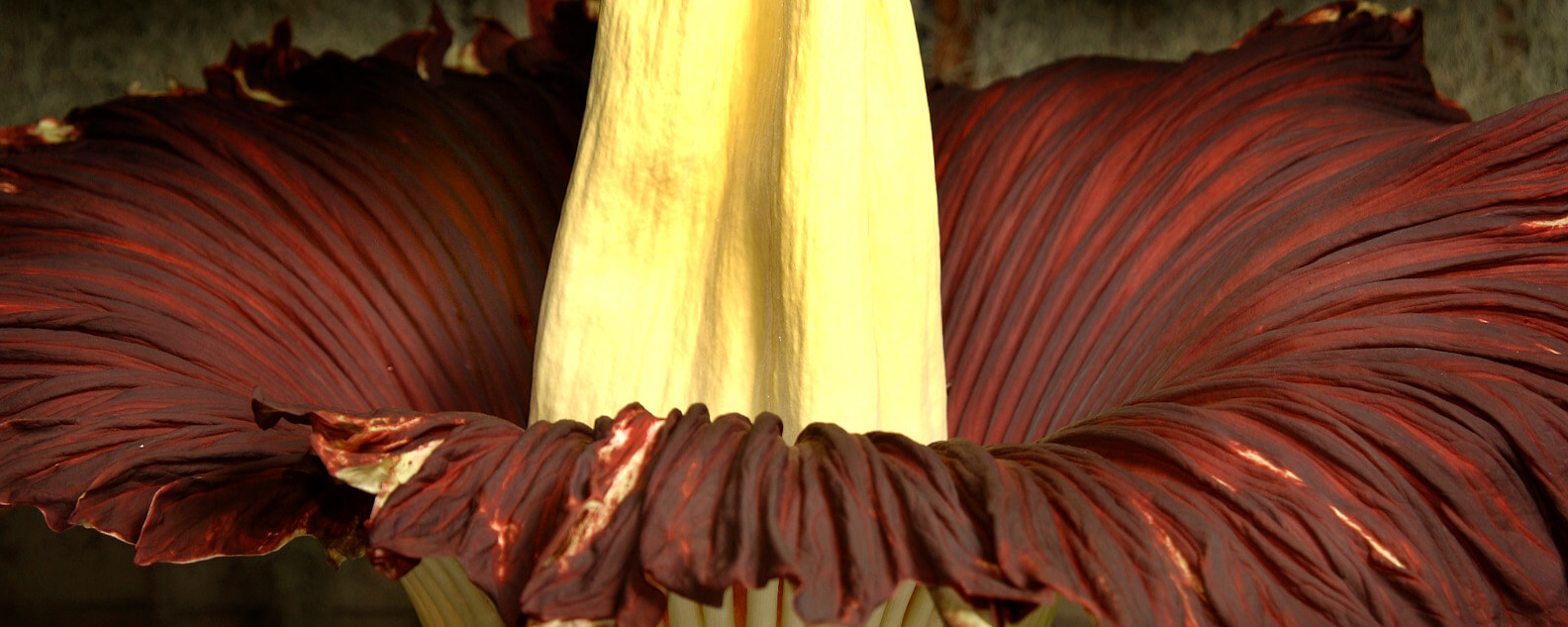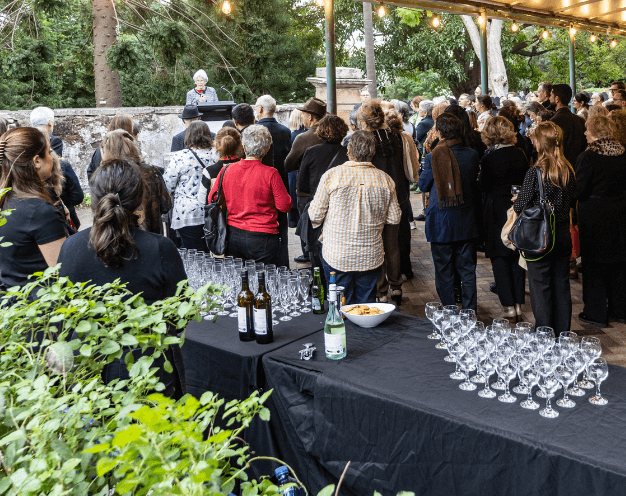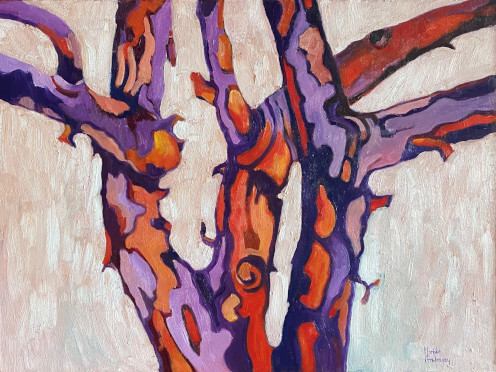Corpse Flower: A Plant to Die For
A Corpse Flower — Bunga Bangkai — has bloomed in Sydney for the first time in fifteen years.

Palm House, Royal Botanic Garden Sydney enter via Woolloomooloo Gate
On display from Friday 17 January until Friday 24 January 2025.
Open 8am - midnight during blooming (queue will close earlier, once at capacity).
Entry by donation
Bunga Bangkai (Indonesian), Titan Arum or Amorphophallus titanum has the biggest, smelliest flower-spike in the world. It flowers for just 24 hours, once every few years… and one has just bloomed at the Royal Botanic Garden Sydney.
What is it?
Found only in the rainforests of western Sumatra, the rare and endangered Corpse Flower plant is renowned for the smell of putrid, rotting flesh that surround the flowers when it blooms.
People have described the smell as like wet socks, hot cat food, or rotting possum flesh. But wouldn’t you like to find out for yourself?
What’s happening?
There are several Corpse Flower plants in different stages of growth in the Aroid glasshouse in the nursery. Despite this, blooms are very rare, occurring for just 24 hours every few years. This was the fifth time a Corpse Flower has bloomed at the Royal Botanic Garden Sydney, with various plants in our collection previously flowering in 2010, 2008, 2004 and a double bloom in 2006.
In late December 2024, horticulturalists working in the glasshouse noticed the initial clues that one might be entering the flowering stage. Daily measurements and close observation began, and due to vital information sharing from other botanic gardens across the world about Amorphophallus titanum blooming patterns, the team confirmed that we were likely to have a stinky inflorescence in January 2025!
Where and when can I see it?
You can watch it live online on the Botanic Gardens of Sydney YouTube channel right now.
To visit in person. The plant is on display from 8am until 6pm (weather permitting) everyday from Friday 17 January 2025 in the Palm House at the Royal Botanic Garden Sydney until it starts blooming.
Now that Putricia has bloomed it is time to say goodbye. Tonight is your last opportunity to visit Putricia. Her display will be closing for good at midnight on Friday 24 January.
Support the Gardens
Botanic Gardens of Sydney relies on donations, philanthropic support and partnerships to sustain our wonderful green spaces and critical conservation work.
If you are unable to attend this viewing event but want to support our work please donate here to help protect a multitude of endangered plants, just like the Corpse Flower.
Livestream
Be the first to see it bloom! Watch the Royal Botanic Garden Sydney's Amorphophallus titanum flower live from the oldest glasshouse in New South Wales - Palm House.
Click play on the video below or watch on YouTube.
“If you've got some wet teenage socks, throw that into a blender, then you get some cat food you've left out in the sun, whack that in your blender, and then get some day old vomit. Put that in the blender, blend it all up, rip the lid off. That's the kind of smell you're getting. It’s actually stunningly beautiful as well.”
Paul Nicholson, Manager of Volunteer Programs
FAQs
Entry is via Woolloomooloo Gate on Art Gallery Road. This gate is the closest entry point to Palm House where the Corpse Flower will be on display.
View Woolloomooloo Gate on the map
View Palm House on the map
Parking is limited and we recommend the use of public transport.
Yes, the entry has an accessible option.
Entry to Palm House to see the Corpse Flower is via donation. There are no pre-booked slots for entry, so be prepared to queue! Botanic Gardens of Sydney relies on donations, philanthropic support and partnerships to sustain our wonderful green spaces and critical conservation work.
Entry will be staggered with small groups being allowed in at a time. Palm House is the oldest glasshouse in New South Wales and a heritage building, so space is limited. To ensure the best possible atmosphere for the Amorphophallus titanum all visitors will be asked to sanitise footwear before entry.
If you’re planning to join us, be prepared for all weather conditions. Be sun safe earlier in the day and bring a jumper, poncho or raincoat too. Umbrella use is discouraged and umbrellas over 50cm in length are not permitted. Large bags and umbrellas will be cloaked before entry to Palm House and returned on exit.
Please follow our Instagram and Facebook on the day for important announcements.
For the latest weather forecast, please check the Bureau of Meteorology.
Yes! You are encouraged to take photos with Putricia. Please tag us at @botanicsydney on Instagram and Botanic Gardens of Sydney on Facebook, and use the hashtag #SydneyCorpseFlower
Please be aware that there is a chance that visitors will be captured on the livestream. Areas that are on camera are marked within Palm House.
It has the largest unbranched inflorescence of any plant in the world. That is the largest collection of flowers on one structure, this can be up to 3 metres tall. The largest recorded was 322.5 cm, at Meise Botanic Garden in Belgium. It also is one of the smelliest flowers in the world and is endangered in its natural habitat, the rainforests of Sumatra, Indonesia.
Think of a peace lily, arum lily or monstera flower on steroids. It has a central columnar structure called a spadix surrounded by a beautiful, pleated bract called a spathe. This is lush velvety burgundy on the inside and bright lime green on the outside. The genus name, Amorphophallus means misshapen phallus (penis) in latin, referring to the central spadix. The species epithet, titanum refers to the flowers enormous scale.
To attract pollinators. Carrion beetles and flies are attracted because they want to lay their eggs in a rotting animal corpse. The smell and colour of the flower trick them into visiting and the heat generated by the plant entices them to visit, breed and party. By visiting multiple plants these insects may pollinate the flowers by moving pollen from the male flowers of one plant to the female flowers of another plant. As the plant is rare and flowering time is unpredictable these plants need to do something BIG to attract pollinators.
At night as the female flowers mature. The inflorescence heats up (thermogenesis) as the female flowers become receptive. The hollow spadix acts like a giant chimney spreading the smell and the spathe that surrounds the spadix unfurls, allowing access to the female flowers at the bottom of the spadix.
It lasts for a few hours during the first phase of flowering. The second phase of flowering is when the male flowers start to produce pollen. This generally happens after the female flowers are no longer receptive to avoid self pollination. Although the inflorescence heats up again as male flowers mature and produce pollen the smell has usually dissipated by this stage.
Usually 2-3 days. If flowers are pollinated it will close and so may only last a day. If unpollinated it may last for up to 4 days.
The spathe shrivels and the spadix collapses. If the flowers have been pollinated, then orange fruit, bearing seeds are produced at the base of what remains of the spadix on a structure called an infructescence.
No, the plant is not designed to die after flowering and fruiting. A new single leaf will eventually be produced from the underground corm and the plant will continue to grow. However, so much energy has been expended on flowering and fruiting that it may be years before the plant has enough stored energy to flower again.
It grows from a modified, underground stem called a corm, a bit like a giant potato, which grows from a closely related structure called a tuber. The corm produces a single leaf which just like the flowering structure can get to enormous proportions, up to 5 metres tall and resembling a small fleshy tree. The leaf lives for 1 to 1.5 years during which time it converts the suns energy into sugars and starches via photosynthesis allowing the corm to increase in size and mass. The leaf dies down dramatically, going yellow and collapsing. The plant then goes into a dormant phase which may last up to 6 months before either a new leaf or flower is produced.
Around 7-10 years. The corm needs to be massive enough to have sufficient stored energy and nutrients to produce a flower. The record holder for most massive corm is 153.9 kg from a plant grown at the Royal Botanic Garden Edinburgh. Corms of around 20 kg are thought to be massive enough to flower.
The earliest recorded flowering was at the Royal Botanic Gardens Kew in 1899. The species was first scientifically described in 1878 by Italian botanist Odoardo Beccari (1843-1920). A plant first flowered at the Royal Botanic Garden Sydney in 2004, followed by flowerings in 2006, 2008 and in 2010.
The structure we are marvelling at produced by the Titan Arum is a collection of flowers called an inflorescence. The largest individual flower in the world is the flower of a parasitic plant called Rafflesia arnoldii from the rainforests of Borneo, that also smells like rotting meat.
No this species is not edible. However, Amorphophallus konjac corms are used to make glassy noodles called Shirataki in Japan.
There are over 250 recognised species around the world. They occur in tropical and southern Africa, Madagascar, Tropical and Subtropical Asia and 2 species in Northern Australia - A.galbra and A.paeoniifolius.
Originally the seed was collected from a wild plant in the area around Bukittinggi in Western Sumatra. Plants from this seed were grown at Mt Lofty Botanic Garden South Australia. Our plant was grown by staff at Mt Lofty Botanic Garden from a leaf cutting of one of these plants and then after a few years sent when the plant was dormant. 12 plants were received, and this is the first one to flower.
The corm arrived from Mt Lofty Botanic Garden in South Australia in September 2020 and has been growing in a glasshouse in our nursery ever since. In 2022 the corm weighed 15 kg.
Yes, the International Union for the Conservation of Nature (IUCN) has classified the species as Endangered with up to 1,000 but probably only around 300 mature individuals left in the wild with the overall population thought to be declining. It is threatened due to land clearing and conversion to palm oil cultivation, land degradation, illegal logging, poaching and sometimes the destruction of the plants because of a local myth that relates to the snake-like appearance of the petiole (the base of the leaf). Some people believe that the plants may harm humans and consequently destroy the plants.
Since its introduction to cultivation in the late 1800s, the species has been grown in over 90 botanic gardens in 18 countries across the world and has successfully flowered around 100 times. Recent studies have been undertaken to better understand the “family trees” of cultivated plants using genetic sampling, Royal Botanic Garden Sydney's plants were sampled as part of this study. This will help inform attempts to breed new genetically diverse plants in cultivation, like zoos do with captive breeding of endangered animals. Over time gardens may be able to hold meta-collections that represent the existing genetic diversity of the species as is being done with Australia’s Wollemi Pine (Wollemia nobilis).
It has been something of a tradition for individual flowering plants in botanic gardens to receive a name. A competition was run amongst staff to name our plant. The winner selected by our judging panel was “Putricia”.
Here are some names of other flowers from around the world:
- Carolus – Cornell University
- Wee Stinky – Cornell University
- Mr. Stinky – Fairchild Tropical Garden
- Plantzilla - Gustavus Adolphus
- Ugly Duckling - Chicago Botanic Garden
- Hope - Chicago Botanic Garden
- Persephone - Chicago Botanic Garden
- Sumatra - Chicago Botanic Garden
- Velvet Queen - Chicago Botanic Garden
- Reekie – Royal Botanic Garden Edinburgh
- Vincent Van Gross - Toronto Zoo
- Pablo Pew-casso - Toronto Zoo
- Sideshow Bob - Toronto Zoo
- Titania - University of California Berkley
- Big Betty – Cooktown
Subscribe to our newsletter
Receive the latest news on horticultural displays, events, exhibitions, science research and special offers.
Discover more events

